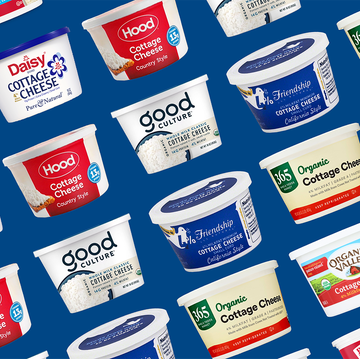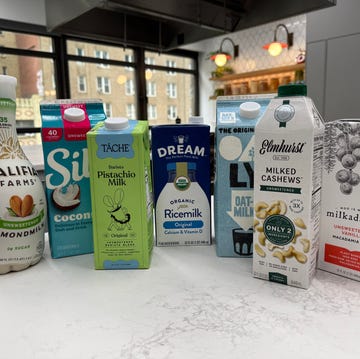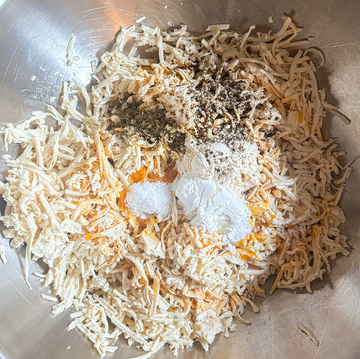The recent news that the FDA has officially banned the use of Red Dye 3 in food and drinks in the United States begs the question—are more bans on the horizon? Currently, there are 40 color additives (eight synthetic) permitted to be used in food, with four pending use in food and drugs. Parenting circles are continuously discussing artificial food coloring and its purported effects on children. In fact, it was a petition filed by advocacy groups back in 2022 that led to the recent ban of Red Dye 3 (more on that later). So just what exactly do parents—and consumers of all kinds—need to know about these substances?
Synthetic dyes have been used commercially since the mid-1800s, however, it wasn't until 1906 that Congress passed the Food and Drugs Act, banning poisonous and harmful color additives in food. Since then, many color additives have come and gone as regulations became stricter and the science became more clear. But one thing that has increased over time is our exposure to these dyes.
"The average person in the United States drinks and eats five times as much food dye today compared to what was consumed in 1955," L. Eugene Arnold, MD, MEd, tells Delish. Aside from the more obvious culprits like candy and cereals, dyes are also commonly used in salmon and other whole foods to boost the vibrancy. They serve no other purpose than to catch the eye, making many snacks and treats particularly attractive to young children. After all, who hasn't been tempted by a rainbow-colored lollipop?
How To Know If There's Synthetic Dye In Your Food
There are many different terms and phrases used to describe the dyes in your food. "Per the FDA, a color can be called 'natural' if it is 'natural to' the food product itself," explains registered dietician Perri Klingbaum. "For example, grape juice can be used to color grape jelly."
Alternatively, if a product's label states "artificial colors" or "certified colors," that means the colors used are man-made and petroleum-based, Klingbaum tells Delish. She also cautions consumers to be mindful of seeing the word "lake" on a label, which refers to a combination of artificial food dyes. Parents should be on the lookout for these terms on ingredient labels if they want to cut back.
A word to the wise: synthetic dyes are most often used in ultra processed food and beverages—items that experts recommend avoiding or limiting regardless. "It's not only the dye that could be an issue," says Klingbaum. "Ultra processed foods themselves are stripped of nutritive value and contribute to negative health outcomes when eaten frequently."
All About The Recent Ban—Will There Be More?
In January 2025, the FDA banned Red Dye No. 3 because its consumption was linked to thyroid cancer in studies done on male rats. (It should be noted that the FDA stated that there is no evidence that Red Dye No. 3 causes cancer in humans.) While the FDA only cited this connection as the impetus for the ban, some studies have shown a link between the dyes and negative behavioral changes in children. These claims are part of the 2022 petition that got the ball rolling on the ban in the first place.
But that doesn't mean the snacks you're eating—or buying your kids—are free from the additive yet. Food companies have until January 15, 2027 to reformulate their products, while drug manufactures have an additional year. So we aren't smooth sailing quite yet.
Klingbaum notes that Red Dye No. 3 can also affect thyroid function, due to the fact that Red 3 is an iodine-based compound, an element required in just the right amounts from your diet for proper thyroid function.
Since the recent ban, many have been wondering if more food coloring bans will follow. "It is a real possibility," Dr. Nayan Patel, Chief Scientific Officer at Thrivelab, tells. "As more research and studies emerge, regulatory institutions find themselves in a position to reassess the risks or health benefits of using synthetic dyes. Recent restrictions imply an increase in its regulation." After all, there is evidence to backup claims that other synthetic dyes negatively impact children's health.
How Artificial Dyes Can Affect Children
Red Dye 40, an even more prominent dye in food and beverages—you'll find it in everything from Cheetos and Doritos to Fruity Pebbles and Kool-Aid—is often considered a better alternative when compared to Red 3. But, Klingbaum says, "There is some emerging evidence to suggest a link between Red 40 and other food dyes and hyperactivity in children."
Some studies show that regulatory levels of artificial coloring agents weren't created with children in mind, and instead are based on much larger adults, indicating that children's exposure to synthetic dyes might exceed regulatory guidelines. These studies call for the FDA to reevaluate its current Acceptable Daily Intake (ADI) levels to take into consideration both children and pregnant women.
Considering many food and drinks marketed towards children contain Red 40 and other vibrant food dyes, this is cause for concern. Red 40 has a different chemical makeup than Red 3, indicating that it does not pose the same carcinogenic risk to the thyroid health.
Even without the cancer risks, other synthetic dyes pose problems for younger generations. Studies suggest that consumption of artificial food dyes can make ADHD and anxiety symptoms in children worse, as well as exacerbate the symptoms of oppositional defiant disorder. There is evidence that suggests these artificial dyes affect not only children with pre-existing neurobehavioral issues, but those without them, along with children in utero, as well.
What We Know About Other Artificial Dyes
Klingbaum thinks it's important to point out that many claims regarding food dyes haven't been tested or reevaluated in years. However, a quick Google search shows that there is merit to the public's concern over Red 40. For example, a 2023 study found that the coloring causes colonic inflammation, impacts the microbiome, and causes DNA damage (in rats).
Dr. Patel cautions consumers to "avoid synthetic dyes like Red 40, Yellow 5, and Blue 1, and instead opt for natural alternatives like turmeric, blueberries, or beetroot," when cooking at home. While these synthetic dyes are currently legal, Dr. Patel explains, "There has been a precedent that links these synthetic dyes to hormonal imbalances, inflammatory processes, and oxidative stress, all of which imply long-term damage to overall health and longevity."
He recommends that hypersensitive individuals and children be particularly cautious with their consumption of products containing synthetic dyes. While they don't present a carcinogenic risk like Red 3, other dyes "have been the motive of several studies regarding hypersensitivity and potential links to hyperactivity in children," Dr. Patel notes.
How To Avoid Artificial Coloring
As Dr. Patel mentioned, there are a handful of natural alternatives you can use in lieu of artificial coloring. "Although integrating natural dyes may require more effort, doing so is a simple and yet impactful step toward promoting hormonal balance, longevity, and general well-being," he tells us. There are also plenty of brands utilizing these natural alternatives for their products.
Klingbaum also points out: "You can also avoid artificial food dyes by choosing organic foods, because certified organic products cannot contain artificial colors."
If you or your children do happen to have the occasional treat with artificial dye, most experts agree it's not a concern. Most synthetic food dyes are recognized as safe by regulatory agencies as long as they are present in small amounts. The FDA, along with other regulatory institutions, determines ADIs for synthetic dyes. These levels, which are presented as a range, are calculated by milligrams per kilogram of bodyweight per day.
"The consumption of an additive above its ADI on a given day is not a cause for concern because the ADI has a large built-in safety factor and in practice, consumption above the ADI on one day is more than accounted for by consumption below the ADI on most other days," states the European Food Information Council. (Keep in mind that some research has found these ADIs to be too high for children, hence many citizens' call for reevaluation.)
Dr. Patel recommends integrating antioxidants like glutathione into your diet, which "will help support the body's natural detoxification processes, mitigating the effects of environmental toxins like the ones found in synthetic dyes." (Always check with your doctor or pediatrician before adding a supplement to your diet, or your child's diet.) Many fruits and other whole foods are packed with antioxidants, as well.
All in all, what this means is that, as Klingbaum says, "When it comes to health, nothing replaces a balanced diet." For you, and for your children.













